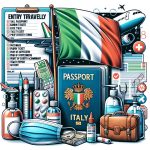Italy, with its rich culture, stunning landscapes, and delicious cuisine, is a dream destination for many travelers. However, before embarking on your Italian adventure, it is crucial to familiarize yourself with the country’s travel entry requirements. This introductory section aims to provide an overview of these requirements and highlight the importance of understanding and complying with them.
In this blog post, we will discuss the general requirements for entering Italy, including the necessity of a valid passport and potential visa requirements based on different traveler types. We will also delve into specific provisions for European Union (EU) citizens, detailing the need for a national identity card or passport and explaining the freedom of movement within the EU.
For non-EU citizens, we will outline the visa requirements for accessing Italy. We will differentiate between short-term and long-term visas and discuss the relevance of the Schengen visa to Italian travel. Additionally, we will provide a comprehensive list of countries whose citizens are exempted from obtaining a visa for Italy and explain any additional requirements for these specific countries.
Furthermore, this blog post will guide individuals through the process of applying for an Italian visa. We will provide a step-by-step guide, highlighting required documents and associated fees while emphasizing the importance of applying well in advance. Additionally, we will address other entry requirements such as health-related necessities, travel insurance obligations for non-EU citizens, proof of accommodation and sufficient funds.
By understanding and complying with Italian travel entry requirements laid out in this blog post can ensure you have a smooth entry into Italy without any complications or unwelcome surprises. So let us dive into these details to facilitate your travel planning process efficiently.
General Overview of Italian Travel Entry Requirements
When planning a trip to Italy, it is crucial to familiarize oneself with the country’s travel entry requirements. This section provides a general overview of these requirements, including the basic necessities for entering Italy and potential visa requirements based on different traveler types.
First and foremost, all travelers visiting Italy must have a valid passport that is not due to expire within six months of their arrival. It is important to ensure that your passport is in good condition and has at least two blank pages for immigration stamps.
In terms of visa requirements, European Union (EU) citizens are generally allowed visa-free travel within Italy. However, they must carry either a national identity card or a passport for identification purposes. EU citizens also benefit from freedom of movement within the EU, allowing them to stay in Italy or any other EU member state for up to 90 days without a visa.
For non-EU citizens, visa requirements depend on the duration and purpose of their visit. Short-term visits, including tourism or business trips, usually fall under the Schengen visa agreement. This allows travelers from certain countries to enter Italy and other Schengen Area countries for up to 90 days within a 180-day period without needing an additional visa. Longer-term stays and specific purposes may require different types of visas.
Having an understanding of these general entry requirements will help ensure a smooth and hassle-free journey to Italy. Make sure you check the specific entry provisions based on your nationality and purpose of travel well in advance to avoid any last-minute complications.
| Entry Requirement | Description |
|---|---|
| Valid Passport | Passport must be valid for at least six months beyond the date of entry. |
| Schengen Visa | Non-EU citizens may require a Schengen visa for stays up to 90 days within a 180-day period. |
| Long-Term Visa | For longer stays or specific purposes of travel, non-EU citizens may need to apply for a different type of visa. |
Visa-Free Travel for EU Citizens
As a member of the European Union (EU), citizens from EU countries have certain privileges and exemptions when it comes to traveling to Italy. This section will provide a detailed overview of the entry provisions for EU citizens and highlight the need for a national identity card or passport.
For EU citizens, traveling to Italy is relatively straightforward. In most cases, a valid national identity card or passport is sufficient for entry. This means that EU citizens do not need to go through the process of obtaining a visa before their trip. The national identity card or passport serves as proof of citizenship and allows for freedom of movement within the EU.
It is important to note that while a visa may not be required, EU travelers still need to ensure that their identification document meets the validity requirements set by Italian authorities. Additionally, it is advisable to carry travel insurance, as it provides coverage in case of any unforeseen circumstances during your trip.
For those planning on staying in Italy for longer periods or for specific purposes such as work or study, different regulations may apply. In such cases, it is recommended to consult with the Italian embassy or consulate in your home country to determine if any additional documents or permits are required.
In summary, EU citizens benefit from visa-free travel when visiting Italy. With just a valid national identity card or passport, they can enjoy the freedom of movement within the country and make their journey hassle-free.
- Valid national identity card or passport is sufficient for EU citizens
- No need to obtain a visa beforehand
- Proof of citizenship allows freedom of movement within the EU
- Consult embassy/ consulate for longer stays or specific purposes
Visa Requirements for Non-EU Citizens
Short-Term Visas
For non-EU citizens planning to visit Italy for a short duration, it is important to familiarize yourself with the visa requirements. Short-term visas, also known as Schengen visas, are required for stays of up to 90 days within a 180-day period. These visas allow tourists and business travelers to enter Italy and other Schengen Area countries.
To obtain a short-term visa for Italy, non-EU citizens must submit an application at an Italian embassy or consulate in their home country. The application process typically involves providing a valid passport, proof of travel insurance, a completed application form, and supporting documents such as flight reservations and accommodation bookings. It is advisable to apply well in advance of your planned trip as visa processing can take several weeks.
Long-Term Visas
If you plan to stay in Italy for more than 90 days or have specific purposes such as work or study, you will need to apply for a long-term visa. The requirements and procedures for obtaining a long-term visa may vary depending on the purpose of your stay. Some common types of long-term visas include student visas, work visas, and family reunification visas.
Long-term visa applications typically require additional documentation compared to short-term visas. These may include acceptance letters from Italian educational institutions, employment contracts or job offers from Italian companies, proof of financial means to support yourself during your stay, and sometimes even criminal background checks.
It is important to thoroughly research the specific requirements for the type of long-term visa you need before starting the application process. You may need to make an appointment at an Italian embassy or consulate in your home country and be prepared for potential interviews about your travel plans.
Schengen Visa
When discussing travel entry requirements for Italy, it is important to understand the concept of the Schengen Agreement. Italy is part of the Schengen Area, which consists of 26 European countries that have abolished internal borders, allowing free movement between them. This means that a Schengen visa obtained for Italy also grants the traveler access to other Schengen Area countries during their stay.
The Schengen visa is valid for a maximum of 90 days within a 180-day period and allows multiple entries into the Schengen Area. It is important to note that exceeding the permitted duration or engaging in activities not allowed by your visa, such as working without the appropriate authorization, can result in serious consequences, including fines, deportation, and future travel restrictions.
Non-EU citizens should carefully plan their itineraries and ensure compliance with the Schengen rules to avoid any legal issues during their stay in Italy.
Visa-Free Travel for Citizens of Specific Countries
Visa Exemptions and Permissible Duration
Italy offers visa-free travel to citizens of specific countries, allowing them to enter the country without obtaining a visa beforehand. These countries have established agreements with Italy that facilitate ease of travel for their citizens. It is important to note that while these travelers do not need a visa, they still need to meet certain requirements upon arrival in Italy.
The list of countries whose citizens are exempt from obtaining a visa for Italy includes several nations from Europe, such as the United Kingdom, Switzerland, Norway, and Iceland. Additionally, citizens of some non-European countries like the United States, Canada, Australia, and New Zealand also enjoy this privilege. The duration of stay varies depending on the traveler’s nationality and purpose of visit, but it generally ranges from 90 days within any 180-day period to 180 days.
Additional Requirements for Visa-Free Travelers
While citizens from these countries do not require a visa for Italy, there are additional requirements they must fulfill in order to be granted entry into the country. One important requirement is having a valid passport that is valid for at least three months beyond the intended stay in Italy. Travelers must also possess proof of sufficient funds to finance their stay and return transportation tickets or sufficient funds to purchase them.
Another requirement for visa-free travelers is having proof of accommodation for their entire stay in Italy. This can be in the form of hotel reservations or an invitation letter from a host stating that accommodation will be provided during their visit. It is important to ensure that all these documents are ready and available at immigration checkpoints when entering Italy.
Citizens of specific countries who are exempted from obtaining a visa for Italy enjoy certain privileges when traveling to the country. However, it is crucial that they familiarize themselves with the additional requirements and conditions set forth by Italian authorities.
By ensuring they have a valid passport, proof of sufficient funds and accommodation, and adhering to the permissible duration of stay, travelers can ensure a smooth entry into Italy. It is always recommended to check the latest travel information and requirements from the Italian embassy or consulate before planning a trip to Italy.
Applying for an Italian Visa
If you are planning to travel to Italy and you are not a citizen of the European Union (EU), it is important to familiarize yourself with the visa requirements. This section will guide you through the process of applying for an Italian visa, ensuring that your entry into Italy goes smoothly.
Step-by-Step Guide
To apply for an Italian visa, follow these steps:
- Gather the required documents: Start by gathering all the necessary documents for your visa application. These may include a completed visa application form, a valid passport, proof of accommodation in Italy, travel itinerary, proof of financial means to support your stay, and other supporting documents specific to your purpose of travel (e.g., invitation letter from a business partner or university acceptance letter).
- Schedule an appointment: Visit the official website of the Italian embassy or consulate in your country to schedule an appointment. You will be required to submit your application and biometric data (such as fingerprints) in person.
- Complete the visa application form: Fill out the application form accurately and honestly. Make sure all information provided is correct and up-to-date.
- Attend the appointment: On the scheduled date and time, attend your appointment at the Italian embassy or consulate. Submit your completed application form and all required documents. Your biometric data will also be collected during this visit.
- Pay the visa fee: Pay the necessary visa fee as specified by the embassy or consulate. Keep in mind that this fee is non-refundable even if your visa application is rejected.
Application Process and Associated Fees
The processing time for an Italian visa can vary depending on various factors such as nationality, purpose of travel, and time of year. It is advisable to apply well in advance to allow sufficient processing time. The visa fee also varies depending on the type of visa and the age of the applicant.
Importance of Applying in Advance
It is crucial to apply for an Italian visa well in advance of your intended travel dates. This will allow enough time for the embassy or consulate to process your application, conduct any necessary interviews, and make a decision. Applying early will also give you ample time to resolve any issues or provide additional documents if requested by the authorities.
By following these steps and ensuring that you have all the required documents, you can be better prepared for the Italian visa application process. Remember that this section provides only a general overview and it is important to consult the official website of the Italian embassy or consulate in your country for more detailed information and specific requirements related to your circumstances.
Additional Travel Entry Requirements
When planning a trip to Italy, it is essential to familiarize oneself with the additional travel entry requirements beyond visas and passports. These requirements may include health-related considerations, proof of accommodation and sufficient funds, and the need for travel insurance. By being aware of these requirements in advance, travelers can ensure a smooth entry into Italy.
One important aspect of additional travel entry requirements is health-related considerations. While Italy does not typically require specific vaccinations for entry, it is recommended that travelers are up-to-date on routine vaccinations before visiting the country. It is also advisable to have travel medical insurance that covers any healthcare or medical emergencies during the trip. This will provide peace of mind and financial protection in case of any unexpected medical situations.
In addition to health-related requirements, it is crucial to have proof of accommodation and sufficient funds when entering Italy. Immigration officials may ask for evidence of where you will be staying during your visit, so it is important to carry documentation such as hotel reservations or accommodations confirmation. Furthermore, having proof of sufficient funds that cover your stay in Italy can demonstrate your ability to support yourself financially while in the country.
It’s important to note that for non-EU citizens, travel insurance becomes even more significant. Non-EU citizens are required to have valid travel medical insurance that covers their entire stay in Italy. This requirement ensures that visitors have access to necessary healthcare services without placing a burden on the Italian healthcare system.
| Additional Travel Entry Requirements |
|---|
| Health-related considerations |
| Proof of accommodation |
| Sufficient funds |
| Travel insurance for non-EU citizens |
Traveling with Children and Minors
Traveling to Italy with children and minors requires additional preparation and documentation to ensure a smooth entry into the country. Italian immigration authorities have specific requirements for minors traveling alone, with only one parent or guardian, or with both parents or guardians. It is important to familiarize yourself with these requirements before your trip to avoid any complications at the border.
When traveling with minors, it is essential to have the necessary consent letters if one or both parents are not present. Italian authorities may ask for proof of consent from the absent parent(s) to verify that the child is allowed to travel. The consent letter should include detailed information about the child, including their name, date of birth, passport details, as well as contact information for both parents or guardians.
It should also state the dates of travel and any other relevant details. It is recommended to have this letter notarized and translated into Italian for further authenticity.
Additionally, it is important to carry appropriate identification documents for children when traveling to Italy. All children, regardless of age, must have a valid passport in order to enter the country. Birth certificates will not be accepted as a substitute for a passport. Make sure that your child’s passport is valid for at least six months beyond the date of entry into Italy.
In some cases, additional documentation may be required depending on individual circumstances. For example, if one parent has sole custody of the child or if there has been a change in custody arrangements, it is advisable to carry relevant legal documents such as court orders or divorce decrees to establish parental rights.
By understanding the specific requirements for traveling with children and minors, you can ensure a hassle-free entry into Italy. Remember to carefully review all necessary documents before your trip and carry copies with you during your travels. Being well-prepared will help you avoid any complications and make your journey more enjoyable for everyone involved.
Conclusion
In conclusion, it is crucial to familiarize oneself with the Italian travel entry requirements in order to ensure a smooth entry into the country. This blog post has provided a comprehensive overview of the various aspects of these requirements. From the general requirements including a valid passport and potential visa needs for different traveler types, to specific provisions for EU citizens and citizens of specific countries, all necessary information has been covered.
For EU citizens, it is important to have either a national identity card or passport when entering Italy. The freedom of movement within the EU allows for seamless travel between member states, but proper identification is still necessary. Non-EU citizens must adhere to different visa requirements depending on their purpose of travel and duration of stay. The Schengen visa is particularly relevant for those planning to visit multiple European countries.
It is also important to note additional entry requirements such as health-related considerations (vaccinations, medical insurance), travel insurance for non-EU citizens, proof of accommodation, sufficient funds, and specific requirements for traveling with children. By meeting all of these prerequisites and having all required documents in order, travelers can ensure a hassle-free entry into Italy.

I’m a passionate traveler, writer, and Italophile. My fascination with Italy’s history, art, and culture has led me on countless adventures across the Italian landscape. Through “I Live Italy,” I share my love for this extraordinary country and aims to inspire others to explore its boundless beauty.





